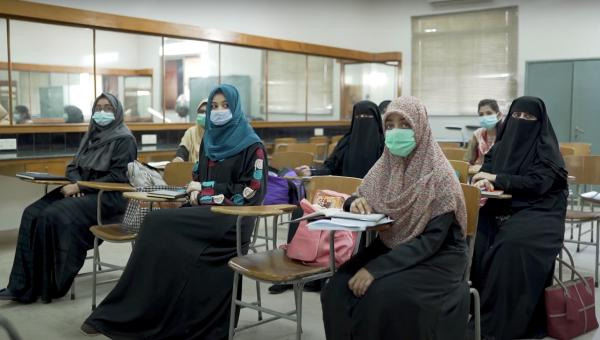Achieving Sustainable Development Goal 4 (SDG-goal 4) has been a crucial agenda for the Pakistani education system to achieve the quality of education that has been debated for many years. Numerous education reforms and intervention plans have been adopted to address the quality issue in all levels of the education system. One of the substantial barriers to quality education relates to inadequately prepared teachers who often demonstrate low enthusiasm to directly impact student learning outcomes. Teachers having undertaken their professional education but departing their courses with limited knowledge of inclusion and without a robust groundwork in inclusive teaching practices are likely to struggle to address the needs of students from diverse backgrounds, including those with disabilities or from marginalized communities. Thus, in pursuing the agenda of including all children irrespective of ability or disability it is crucial that university educators prepare student teachers with the critical pedagogical skills to enable them to cater for the needs of learners with diverse disabilities. Grounded upon my decade research on reforming teacher education I conclude that initial teacher education should find the pathways by which theory and practice can be better integrated. One indispensable aspect of this ‘twin’ relationship, as evidenced by my research is that teacher preparation might best occur through student teachers being availed of the opportunity to work collaboratively with classroom teachers in the constructing and exercising their professional knowledge.
In Pakistan, the State has taken steps in regard to the enhancement of inclusive education through embracing the execution of the National Education Policy and the implementation of the Sustainable Development Goals (SDGs) to affirm the value of inclusive and equitable quality education for all. However, the need to translate policy legislation into practice is one that has been currently sidelined. To overcome this stalemate, it seems necessary that university faculties invite different stakeholders’ to collaborate in the change agenda and thereby transfer to some extent the responsibility of creating a viable, functional, concrete model representing the training process for teaching students.
This approach to some extent looks to western universities that are adopting inclusive collaborative models to prepare teacher educators to cater for learners with diverse needs. Since this collaborative model did not exist in Pakistani teacher education programs, I adopted this model to experiment with the agenda of university and school collaboration to integrate inclusive practices in my recently sponsored Higher Education Commission project, Pakistan. I employed the “3-H model addressing Heart, Head, and Hands” apprenticeship for navigating the emotional, cognitive, and practical dimensions of teaching and learning. This inclusive model originated in the work of Australian researchers, notably Umesh Sharma from Monash University who discovered the promising results in preparing teachers for the implementation of inclusive practices.
Pakistan’s education system is characterized by a wide range of disparities, including those related to socioeconomic status, geographical location, and disabilities. This holistic 3-H apprenticeship approach to inclusive education is not only essential for promoting a supportive and accessible learning environment but also for empowering educators to effectively meet the needs of all students, irrespective of their abilities or diverse backgrounds. I trained almost two hundred student teachers at a public university with the apprenticeship model to integrate inclusion by heart, head and hands in collaboration with the university faculty and school staff. Different cohorts of student teachers engaged with the university faculty and school educators to learn the concepts of inclusion encapsulated by heart, head and hands through inclusive pedagogies.
Teacher candidates were taught the first component of inclusion by ‘Heart’ that creates significant connections with their students to promote understanding, and mutual respect that allows students to feel safe and valued; these are indispensable in creating a positive learning environment. A sense of belongingness, including all, and feeling for others were demonstrated through teacher educators developing the emotional and social relationship with students. Second, the component of inclusion by ‘Head’ apprenticeship emphasizes the importance of promoting cognitive engagement and critical thinking in teaching. Student teachers worked collaboratively with the university and school educators to learn about the skill of differentiating instruction to meet the diverse learning needs of their students. This includes adapting curriculum materials, using a variety of teaching methods, and assessing students’ progress in ways that promote inclusive practice. For instance, a teacher may need to modify a lesson plan to accommodate a student with a visual impairment or to design an assessment that allows students with different abilities to demonstrate their understanding, such as responding orally because written skills are inadequately developed. The third component of inclusion by ‘Hands’ focuses on the practical application of teaching strategies and the development of skills that are essential for inclusive education. Teacher candidates were trained how to translate learning theories into practice through a collaborative approach. They were provided different teaching scenarios for role modelling and were given feedback from supervisory classroom teachers how they might address students’ learning difficulties to further enhance their responses. Also, student teachers worked in collaboration to co-teach as part of the peer mentoring process for microteaching to build their skills and knowledge in inclusive contexts education.
As a result of my project findings, I learnt the effectiveness of the collaborative model through the university and school partnership in translating the learning theories into practice to address inclusion. This project has provided the baseline structure of the collaborative model that can be utilized to prepare teacher candidates to apply inclusive practices with hands-on activities. However, the success of this approach depends on the commitment of the entire education system, including policymakers, school administrators, university, teacher educators and the broader academic community to implement this strategy. Inclusion is a concept that requires the recognition of the strengths of all members in a community. To achieve this recognition and fulfillment requires the collaborative effort of all parties in any context whether it is in schools, workplaces, or in the broader society.





















